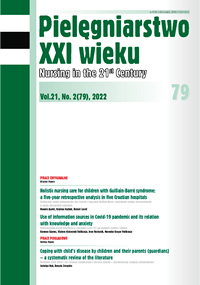Holistic nursing care for children with Guillain- Barré syndrome: a five-year retrospective analysis in five Croatian hospitals
DOI:
https://doi.org/10.2478/pielxxiw-2022-0012Keywords:
Guillain-Barré Syndrome, holistic health, nurses, patient care management, pediatricsAbstract
HOLISTIC NURSING CARE FOR CHILDREN WITH GUILLAIN-BARRÉ SYNDROME: A FIVE-YEAR RETROSPECTIVE ANALYSIS IN FIVE CROATIAN HOSPITALS
Aim. The study aimed to analyze nursing diagnoses defined during the care of children with Guillain-Barré syndrome and to present the specifics of holistic pediatric care.
Material and methods. A retrospective analysis of nursing documentation was conducted on 14 children with Guillain-Barré syndrome hospitalized between 2015 and 2019 in five Croatian hospitals.
Results. The study included 10 (71.4%) boys and 4 (28.6%) girls (8 months – 17 years of age). The average duration of hospitalization was 12.2 days. At plateau, 5 (35.7%) children had minor changes in consciousness and 6 (42.9%) required assistance and/or some supervision in performing self-care activities. Oxygen was administered to one child, and a central venous catheter (CVC) was placed in 3 (21.4 %) children. Thirteen (92.9%) children reported pain. The risk for infection was recorded in 11 (78.6 %) children. Lumbar puncture was performed in all children, while immunotherapy was administered to 13 (92.9%) of them. The care of a CVC and breathing exercises were performed in 3 (21.4%) children. Two (14.3%) children required intensive care.
Conclusions. The unpredictable development and outcome of the Guillain-Barré syndrome require complex holistic pediatric care that represents a significant professional and personal challenge for the nurses
References
1. Kılıc B, Gungor S, Ozgor B. Clinical, electrophysiological findings and evaluation of prognosis of patients with Guillain-Barre syndrome. Turk J Pediatr. 2019;61(2):200- 208.
2. Rosen BA. Guillain-Barre syndrome. Pediatr Rev. 2012;33(4):164-170.
3. Lyons R. Elusive belly pain and Guillain-Barre syndrome. J Pediatr Health Care. 2008;22(5):310-314.
4. Barzegar M. Childhood Guillain-Barre syndrome. Iran J Child Neurology. 2009;3(1):7-14.
5. Agrawal S, Peake D, Whitehouse WP. Management of children with Guillain-Barre syndrome. Arch Dis Child Educ Pract Ed. 2007;92(6):161-168.
6. El Mezzeoui S, Aftiss FZ, Aabdi M, et al. Guillan barre syndrome in post Covid-19 infection in children. Ann Med Surg (Lond). 2021;67:102524.
7. Panda PK, Sharawat IK, Panda P, et al. Neurological Complications of SARS-CoV-2 Infection in Children: A Systematic Review and Meta-Analysis. J Trop Pediatr. 2021;67(3):fmaa070.
8. Sansone P, Giaccari LG, Aurilio C, et al. Post-Infectious Guillain-Barre Syndrome Related to SARS-CoV-2 Infection: A Systematic Review. Life (Basel). 2021;11(2):167.
9. Walsh S. Girl with a cough and leg pain. J Pediatr Health Care. 2001;15(1):41, 45-6.
10. Broadwell Jackson D, Saunders RB. Child Health Nursing. Philadelphia: Lippincott; 1993.
11. Kudhaer W, Mua’ala E. Assessment of Nurses’ Knowledge toward Children with Guillain-Barre Syndrome at Pediatric Hospitals in Baghdad City. Iraqi Sci. J. Nursing. 2010;23(2):66-75.
12. Working group of the Croatian Nursing Council. Proposal of nursing documentation of a pediatric patient. HKMS. Forthcoming 2019.
13. McGrogan A, Madle GC, Seaman HE, et al. The epidemiology of Guillain-Barre syndrome worldwide. A systematic literature review. Neuroepidemiology. 2009;32(2):150-163.
14. Estrade S, Guiomard C, Fabry V, et al. Prognostic factors for the sequelae and severity of Guillain-Barre syndrome in children. Muscle Nerve. 2019;60(6):716-723.
15. Hu MH, Chen CM, Lin KL, et al. Risk Factors of Respiratory Failure in Children with Guillain-Barre Syndrome. Pediatr Neonatol. 2012;53(5):295-299.
16. Koul RL, Alfutaisi A. Prospective study of children with Guillain-Barre syndrome. Indian J Pediatr. 2008;75(8):780 -790.
17. Asbury AK. New concepts of Guillain-Barre syndrome. J Child Neurol. 2000;15(3):183- 191.
18. Koul R, Al-Futaisi A, Chacko A, et al. Clinical characteristics of childhood Guillain- Barre syndrome. Oman Med J. 2008;23(3):158-161.
19. Sudulagunta SR, Sodalagunta MB, Sepehrar M, et al. Guillain-Barre syndrome: clinical profile and management. Ger Med Sci. 2015;13:16.
20. Jasti AK, Selmi C, Sarmiento-Monroy JC, et al. Guillain-Barre syndrome: causes, immunopathogenic mechanisms and treatment. Expert Rev Clin Immunol. 2016;12(11):1175-1189.
21. van Leeuwen N, Lingsma HF, Vanrolleghem AM, et al. Hospital Admissions, Transfers and Costs of Guillain-Barre Syndrome. PLoS One. 2016;11(2):e0143837.
22. Curtis M, Bhumbra S, Felker MV, et al. Guillain-Barre Syndrome in a Child With COVID-19 Infection. Pediatrics. 2021;147(4):e2020015115.
23. Dittmer DK, Teasell R. Complications of immobilization and bed rest. Part 1: Musculoskeletal and cardiovascular complications. Can Fam Physician. 1993;39:1428-1432, 1435-1437.
24. Watson L, Aziz M, Vassallo G, et al. Bladder dysfunction and hypertension in children with Guillain-Barre syndrome. Pediatr Nephrol. 2014;29(9):1637-1641.
25. Sasso A, Radić Nišević J. Acute inflammatory demyelinating polyneuropathy
(Guillain-Barre Syndrome). Paediatr Croat. 2013;57(1):42-47.
26. Ghaedi E, Kianifar H, Imani B, et al. Superior mesenteric artery syndrome in a child with acute gastric dilatation with refractory Guillain-Barre syndrome. Clin Nutr ESPEN. 2019;32:40-43.
27. Kalita J, Kumar M, Misra UK. Prospective comparison of acute motor amonal neuropathy and acute inflammatory demyelinating polyradiculoneuropathy in 140 children with Guillain-Barre syndrome in India. Muscle Nerve. 2018;57(5):761-765.
28. Wu X, Shen D, Li T, et al. Distinct Clinical Characteristics of Pediatric Guillain-Barre Syndrome: A Comparative Study between Children and Adults in Northeast China. PLoS One. 2016;11(3):e0151611.
29. Suzuki T, Hashimoto Y, Anzai S, et al. A case of Guillain-Barre syndrome with severe pain successfully controlled with acetaminophen, gabapentin, and parenteralny infused fentanyl. No To Hattatsu. 2014;46(4):290-296.
Downloads
Published
Issue
Section
License
Copyright (c) 2022 Authors

This work is licensed under a Creative Commons Attribution 4.0 International License.




